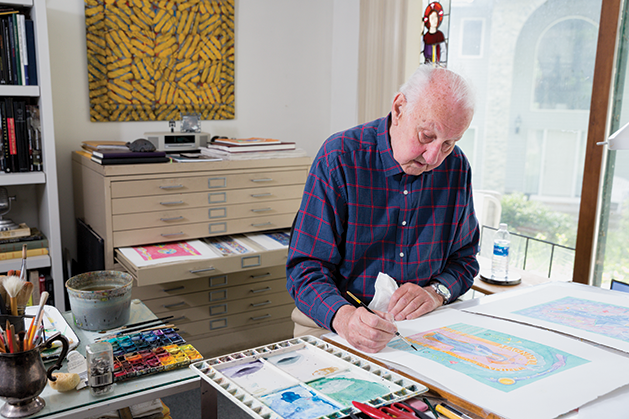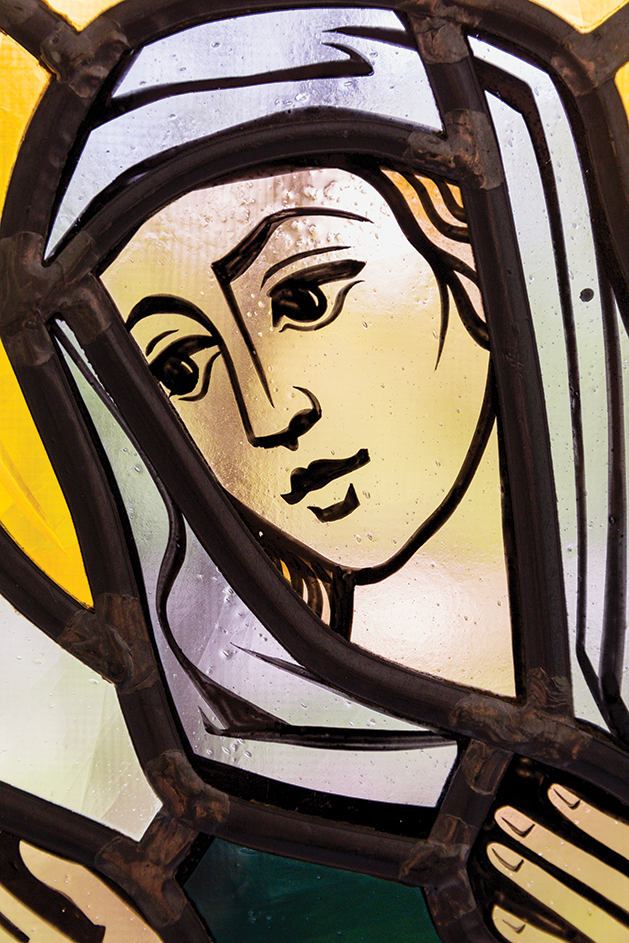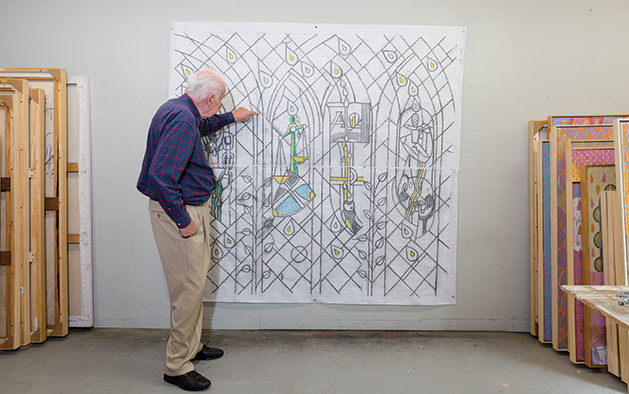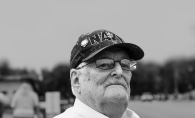
If you’ve driven on Highway 7 at night and happened past Excelsior United Methodist Church, you might already know the work of artist Dieterich Spahn. “We often get comments from passers-by,” says pastor Katie Schneider-Bryan. “All four walls of our sanctuary are covered with Spahn’s stained glass, but the window facing Highway 7, our ‘Resurrection Window,’ is the largest [nearly 30 feet high]. It is an expression of light and hope.” Schneider-Bryan goes on to say that for her, and for many people of faith, beauty expresses who God is. In the case of their particular congregation, she adds, the many radiant colors of the window—which depicts Christ’s resurrection in reds, oranges, yellow, greens and blues—also have a special meaning. “If you come into our sanctuary, in certain light the reflection onto the pews and even the ceiling is of all these rainbow colors. It’s beautiful but also symbolic. We hope all Christians who walk through our doors will feel welcome,” she says.
That might be a lot of work for one window to do, but Spahn is clearly up to the task.
A talent for design
Spahn now lives in Minnetonka, but he was born in Germany and received much of his artistic training there. “I remember my father asked me when I was 11, ‘What do you want to do when you grow up?’ ‘I want to be an artist,’ I told him. ‘You’re nuts,’ he said. ‘You shouldn’t even think about it.’ But I didn’t have to defy him. He was pretty laid back. He said, ‘Well, if that’s what you want to do, do it. Just don’t forget you need money to live,’” Spahn says.
It seems Spahn needn’t worry much about the money these days. His preferred media include watercolors, oils, mosaics, tapestry and stained glass. He has only ever done the design, and not the actual construction, of these last three. He credits his European training in fine arts for the design expertise he gained at an early age. “You have to design,” one of his professors told him. “You do it so quickly, and you understand it.” And while his talents are many, Spahn doesn’t shy away from revealing his “favorite child:” stained glass, he says, “because I’ve known it so well, and done it so long. Stained glass is the queen of the arts.”
Spahn came to the U.S. in 1961, when he was in his 20s, in part because of the relative popularity of stained glass in Europe. “I came because the market was full [in Germany],” he says. There were many older, more experienced and more connected artists who were getting all the work, he explains. “When I came here, and particularly to Minnesota, I found people were very open to spirituality being expressed in art that is contemporary,” he says. Particularly regarding glass, he says, Germany was much more traditional. In a way, he says, his contemporary approach to stained glass art may have secured work that would be there for him for years to come. Traditional stained glass is prohibitively expensive to produce. “The cost drove us to simpler glass,” he says. “It is just as inspiring and interesting.”
Making sacred art
In his spacious studio, where he works too hard, he says with winking irony, there is an easel with several watercolor paintings. They are ideas, says Spahn, for a stained glass panel, or more likely a tapestry, for other churches. Although not much larger than sheets of loose leaf paper, the detail in the paintings’ three sacred images—a lamb of God, a tree of life, an image of Mary wearing a crown—are striking. It almost begs the question: Is Spahn a person of faith, himself?
He sighs and pauses. “You know, I look at faith, particularly the Christian faith, I look at it from an artist’s point of view. The important thing is how I can convey, as an artist, the scene people want in their church to inspire them. It’s outwardly directed. I listen to them, find out what is important to them and then I interpret that,” he says. And he’s done it hundreds of times, in 370 stained glass commissions for places of worship, hospitals, universities and private residences.
On a computer in his studio, he shows me photographs of several pieces commissioned for him at Our Lady of Grace (OLG) Church in Edina. Spahn points out innumerable sacred symbols in a spectacular, multi-paneled stained glass piece currently hanging in the OLG chapel: Seven angels represent the seven flames of the Holy Spirit; 12 leaves represent the 12 apostles; other symbols are of marriage, baptism and communion. “I think this is the nicest chapel in all of the Twin Cities,” he says.
The former pastor of OLG, Father Bob Schwartz, agrees. “I purchased all that [chapel] art,” he says. “I love it. It’s beautiful work.” Father Schwartz says he gave Spahn the general idea for what they wanted—artwork centered on the crucifixion, the nativity and the resurrection—but that from there, Spahn took over. “A lot of times a stained glass window is real opaque, and you can’t see through it,” he says. “But the glass Spahn used in our pieces is different; you can see through a lot of it. So what it tells me is that my faith is something through which I see the world. It’s not something that blocks out the world.”
And with all of that detail and all of that remarkably interpreted symbolism, does he still insist the work is entirely from an artist’s, and not his own personal and spiritual, point of view? “I enjoy the faith,” he says. “I enjoy it intellectually, more than being on a bench and praying. It means a lot that the art goes through me. It’s how I express myself. The ideas that I depict ... they’re always from me.”
Art and family
Spahn married Joanne Shafer in 1980, when he was 42 years old. They had three sons in fairly quick succession: Kevin in 1984, David in 1987 and Alan in 1989. The biggest change his children made in his artwork, he says, is “I had to make the work simpler and faster. I used to spend hours and hours on painting pieces, which of course is laborious as heck, but with the boys I had to find a new way. My outlook on art changed. That’s the part that really changed. I used to take it seriously, and now I don’t take art seriously at all.”
Strong words for an artist, but he sticks to the argument. “A painting is an object that you hang on a wall. When it has light on it, you can see it. And that’s about the only thing a painting can do. It doesn’t talk to you. It can’t do anything. It’s an object to stimulate your eyes,” he says. Once his children were born, he says, his work became more of a mission to support his family. As one of his earliest mentors in the Twin Cities, a man named Percy Ross who helped Spahn early on with the business aspects of his career, might have said, “How are we going to make this work?”
A gentle spirit, and quick
While it appears to the observer Spahn does, in fact, continue to take his art seriously, there is a notably more lighthearted touch to some of his most recent work. In the studio and throughout his home, large oil paintings of a contemporary style, most completed within the last several years, adorn nearly every wall. Some are geometric, inspired by Southwestern U.S. art, Spahn says. There is a beautiful, Japanese-inspired rendition of a knight on horseback. Another is an almost-cubist painting of his wife while she reclined on their deck. “She was watching helicopters,” says Spahn, “so I made this painting where she kind of is a helicopter.” The colors are bright, spring-like. There is clearly a playful feel.
For example, somewhere on each painting, you can find an outline of a rabbit. “It’s my logo,” Spahn says. “You know, the rabbit is a soft animal, and it lives by its wits and its quickness. It’s not aggressive at all. I’ve always thought of it because I am not an aggressive person. I’m laid back, you know? But I’m quick! I’m quick in the head, and quick to do stuff. So that’s basically what the rabbit logo is.”
And then he’s off, already talking about the next spectacular painting.












